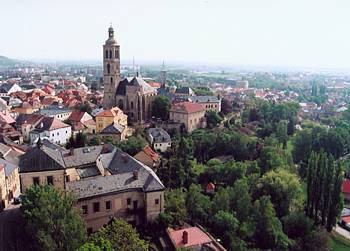History of Hrádek

Almost for 7 centuries Hrádek - eyewitness of the beginning of the town of Kutná Hora - overlooks the valley of the river Vrchlice. It was standing here probably already before the silver rush attracted entrepreneurs and adventurers into this area and brought into existence a mining town, “second in the land right after Prague”.
As a wooden fortress, Hrádek towered above a slope, from which it guarded a trade route crossing the countryside. At the turn of the 13th and the 14th century, it was joined on the slope by a fortified manor-house built up for purposes of newly established central royal mint, the Italian Court of later.
In the first quarter of the 14th century where the first written document of Hrádek originated, there was no St. James Church with its typical tower here, no St. Barbara Cathedral and several centuries were still to pass until the panorama of Kutná Hora was completed by the long silhouette of baroque Jesuit College.
A long and eventful history awaited Hrádek. Wooden, probably fortified redoubt transformed at the time, when the Czech king himself was building his residence in the mint of Kutná Hora, into stone palace of urban style, which came into possession of Václav of Donín, a favourite of king Václav IV.
Even though fires of the town in the years of Hussite revolution consumed most of the written documents including those about history of Hrádek at that time, it is sure it became imposing residence and by its three-floor tower and high gables dominated among others stone buildings of the town.
Its owners, the real as well as those holding it only as a debt security, were coming and going, families of the king’s favourites, municipal and royal officials and newly rich ore merchants were passing through Hrádek. The most significant among them was Jan Smíšek of Vrchoviště, ore and copper merchant, proprietor of mines and several urban houses, member of a large house of lords of Vrchoviště. Till now we admire artificial stone carvings with mining motives as well as painted ceilings, ones of the first expressions of Renaissance in Bohemia, which were created during generous reconstruction of Hrádek in the Jagellonian age. It was apparently secretly and illegally smelted silver ore and unscrupulous trades that made it possible for lord Smíšek to make such a great investment in his residence.
In those days Hrádek became a real pretentious palace with great halls, oriels, tower and even with a chapel. Even though much of this gothic appearance was destroyed by the following proprietors – first of all Jesuits – (for instance a big relief slab above the portal into the banqueting hall or high gothic roofs with gables) so much has survived till now that we can without exaggerating call Hrádek one of the purest expression of by rebuilding untouched Czech Gothic style.
Through a long time the halls of Hrádek were changing from rooms of the Jesuit gymnasium to classrooms of a school and teacher’s institute until in 1910 the town bought Hrádek intending to carry out its restoration and place a museum there. But this intention was not realised until after World War II. The Museum finally settled into the building and in the halls an exposition of the Mining Museum was opened. But the promising development lasted only until the beginning of 1970s. Then the exposition was closed and a new stage of reconstruction was supposed to start. But the interiors of Hrádek remained closed for almost twenty years and waited for completion of major reconstruction works until the middle of 1990s. As the new exposition was opened the atmosphere of the famous period of prosperous Kutná Hora came back into the halls of the castle and Hrádek started to regain its once forgotten cultural and social prestige.
Unofficial opening of the new museum exposition of the Czech Museum of Silver on the newly reconstructed first floor took place in March 1996 for a precious visit, Prince Philip, duke of Edinburgh. This event ushered in a new, socially rich life of Hrádek. The most precious exhibits documenting history of the silver town that used to be an economical base of the Bohemian kingdom returned into the halls of the Museum. Once again, you can hear sounds of concerts and banquets here, festive and diplomatic meetings take place, news conferences are held. Almost no important event can be done without visit of “Hrádek upon Vrchlice”. It is not only destination of diplomatic visits, but also of many tourists. The exposition is seen, on average, by 40 000 people per year. They are attracted also by various temporary exhibitions. Besides, the figure of Jan Smíšek of Vrchoviště itself, his family and citizens of Jagellonian Kutná Hora returned under the Gothic vaults and painted ceilings in form of newly established “Autumn Smíšek Banquet”. Guests of this pageant are in an entertaining way taken back into the time when entrepreneurs of Kutná Hora used to be rich sponsors of culture and building so that they themselves can regain closer relation to their town and its historical monuments.
Czech Museum of Silver,
allowance organisation
Barborská 28
284 01 Kutná Hora
![]() +420 327 512 159
+420 327 512 159
![]() reservations@cms-kh.cz
reservations@cms-kh.cz
(information about tours)
